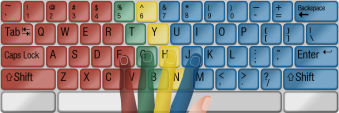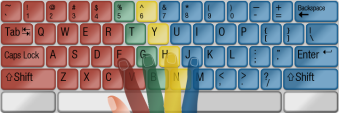Typing: Technique: One Handed Technique
|
|
Position your hand and fingers according to one of the diagrams above. The color coding shows which finger to use to reach each key (you can also view our interactive demonstration). For instance, for a right handed typist, the index finger is used to reach all red keys. For a left handed typist, the index finger is used to reach all blue keys. Most keyboards have small bumps on the F and J keys. These can be used as guides to allow you to position your fingers on the home keys without having to look at the keyboard. Once you feel the bumps on your index and little fingers, you know your fingers are in the right place. Using Sticky Keys to Type Capitals and PunctuationWe recommend turning on the sticky keys option on your computer, in order to speed up entry of capital letters and shifted punctuation. When sticky keys is turned on, it is not necessary to hold down the shift key while pressing another key. Instead, the shift key is pressed and released before pressing the other key. More information on sticky keys can be found here. The exact steps to follow to turn on sticky keys vary from system to system. However, on many computers, you can turn on sticky keys by simply pressing a shift key 5 times rapidly. To type a capital letter or shifted punctuation symbol, first press and release the shift key on the same side of the keyboard as the letter you will type. For instance, to type a capital E, press the shift key on the left side of the keyboard, release the shift key, and then press E. Using the shift key on the same side of the keyboard reduces the amount of hand and finger movement that is needed. Typing Keys on the Outer Edges of the KeyboardFor a one handed typist, it is usually not possible to reach the keys on the extreme left or right side of the keyboard without taking the fingers off of the home position (F, G, H, and J keys). The approach we recommend is to try to keep at least one finger on a home key, to make it easier to return to the home position without looking at the keyboard. For example, a left handed typist may type a backspace by placing their little finger on the J key and their index finger on the backspace key. Because hand sizes can vary, some individuals will need to move their fingers further from the home position than others. For the keys that are far from the home position, feel free to adjust your hand and finger positioning to the point that is most comfortable. Positioning of the KeyboardPlace the keyboard on your desk so that the arm you are using is not bent. This means that right handed typists will place the keyboard on their right and left handed typists will place the keyboard on their left. Some Important Rules to Follow
Next: Finger Placement Demo |

